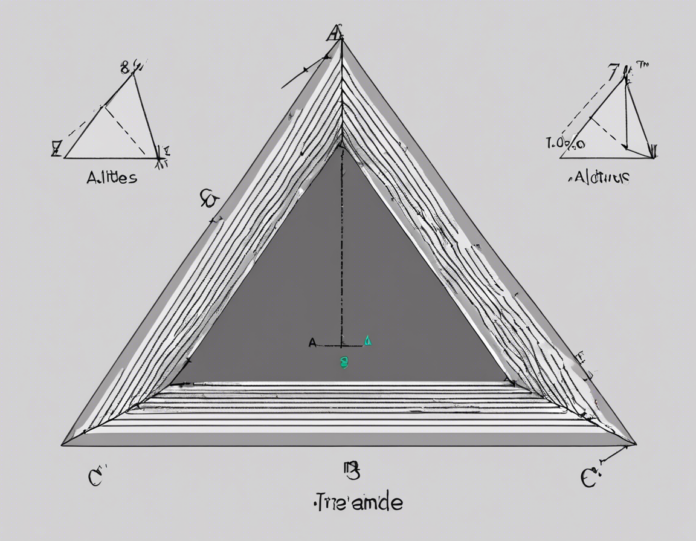Triangles are basic geometric shapes that we encounter frequently in mathematics, engineering, and various other fields. One of the fundamental concepts related to triangles is the altitude. In this article, we will delve into the concept of altitudes in a triangle, their properties, and how they can be used to solve geometric problems.
Understanding Altitudes in a Triangle
In geometry, an altitude of a triangle is a line segment drawn from one of the vertices of the triangle perpendicular to the opposite side. Each triangle has three altitudes, one from each vertex. These altitudes may or may not lie within the interior of the triangle, depending on the type of triangle.
Properties of Altitudes in a Triangle
-
Concurrency: The three altitudes of a triangle are always concurrent, meaning they intersect at a single point called the orthocenter.
-
Right Angles: Each altitude of a triangle forms a right angle with the side it intersects.
-
Bisecting the Base: The altitude drawn from the vertex of a triangle bisects the side it intersects at 90 degrees.
-
Relationship with Orthocenter: The orthocenter of a triangle may lie inside, outside, or on the triangle itself, depending on the type of triangle.
Types of Triangles based on Altitudes
-
Acute Triangle: In an acute triangle, all three altitudes lie within the triangle's interior, and the orthocenter is inside the triangle.
-
Right Triangle: In a right triangle, one of the altitudes coincides with a side of the triangle, and the orthocenter is located at the vertex forming the right angle.
-
Obtuse Triangle: In an obtuse triangle, one of the altitudes lies outside the triangle, and the orthocenter is outside the triangle as well.
Applications of Altitudes in Problem Solving
Altitudes play a crucial role in various geometric problem-solving techniques. Here are some common applications:
1. Area Calculation:
By using the altitude of a triangle, you can easily calculate the area of the triangle using the formula: $Area = 0.5 * base * height$.
2. Orthocenter determination:
Altitudes help in locating the orthocenter of a triangle, which in turn aids in further geometrical derivations and constructions.
3. Angle Calculations:
Altitudes can be used to calculate various angles within a triangle, especially right angles formed with the sides.
Frequently Asked Questions (FAQs) About Altitudes in a Triangle
- How many altitudes does a triangle have?
A triangle has three altitudes, each drawn from a vertex to the opposite side.
- Do all triangles have altitudes?
Yes, all triangles have altitudes, though in some cases, they may lie outside the triangle.
- What is the significance of the orthocenter in a triangle?
The orthocenter of a triangle is the point where all three altitudes intersect. It has important geometric implications and properties.
- How do altitudes help in calculating the area of a triangle?
Altitudes provide the height of the triangle, which, when multiplied by the base and halved, gives the area of the triangle.
- Can an acute triangle have its orthocenter outside the triangle?
No, in an acute triangle, the orthocenter always lies inside the triangle as all altitudes are contained within the triangle.
- How does the length of the altitude affect the area of a triangle?
The longer the altitude of a triangle, the greater the area of the triangle, as area is directly proportional to the height of the triangle.
- Can altitudes of a triangle be equal in length?
Yes, in an isosceles triangle, where two sides are equal, the altitudes drawn from the base to the apex are equal in length.
- What happens if two altitudes of a triangle are perpendicular to each other?
If two altitudes of a triangle are perpendicular to each other, it indicates that the triangle is a right-angled triangle.
- Are altitudes and medians of a triangle the same thing?
No, altitudes and medians of a triangle are different. Altitudes are perpendicular segments from a vertex to the opposite side, while medians are line segments from a vertex to the midpoint of the opposite side.
-
How do altitudes help in proving the congruence of triangles?
Altitudes contribute to proving the congruence of triangles by ensuring that the corresponding sides and angles are equal due to the perpendicular nature of altitudes.
In conclusion, altitudes in a triangle are essential elements that help determine geometric properties, calculate areas, and establish important points like the orthocenter. Understanding the concept of altitudes enhances our grasp of triangle geometry and aids in solving various mathematical problems efficiently.


Recent comments